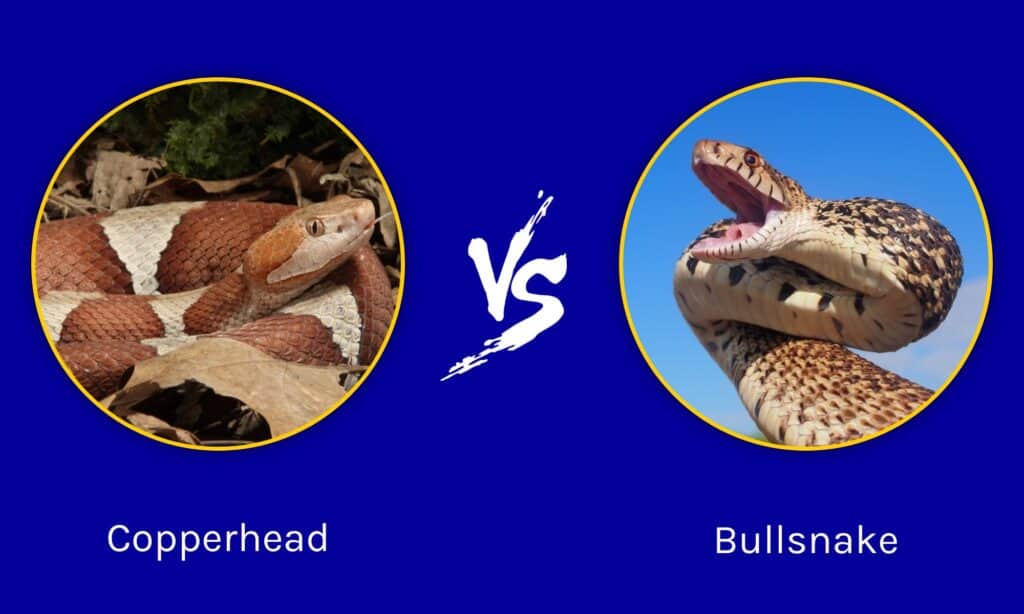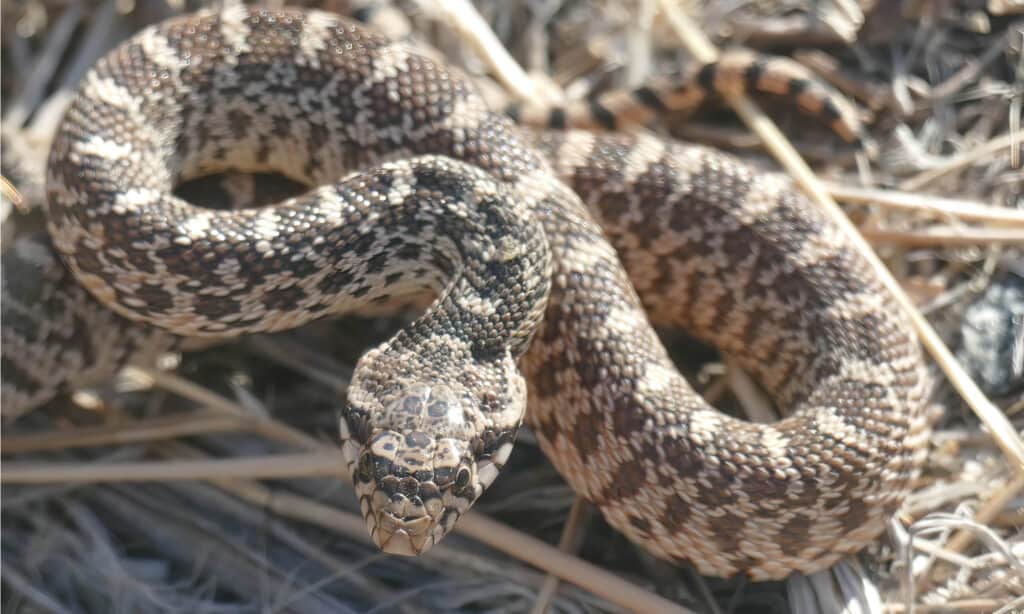Copperheads and bullsnakes are two snakes that are popular in their own rights; copperheads, for their bites, and bullsnakes, for their length. These snakes are so different that they are parallel opposites in most ways.
Not only do they have contrasting features, but they also have significantly different relationships with humans. This article places both snakes side by side to study their differences and similarities.
Comparing the Copperhead and Bullsnake

| Bullsnake | Copperhead | |
|---|---|---|
| Other names | Also called cincuate in Mexico | Also called eastern copperhead or copperhead |
| Size | 2.2–3.3 pounds, may obtain 9.9 pounds. 48 to 72 inches long | 0.2 – 0.7 pounds 20-37 inches |
| Description | Bullsnakes have many color variants including yellow, white, brown, and albinos They are marked with blotches colored white, black, red, or brown | Copper or orange-red triangular heads Pale brown to pinkish-brown background skin Hourglass-shaped markings that are colored copper to reddish-brown |
| Hunting style | Discreet and swift hunters that mimic venomous snakes; Mostly diurnal | Heat-sensing/ infrared pits that help them detect the movement and presence of preyStalk and ambush huntersThey subdue with venom before swallowing their prey wholeDiurnal in the spring and fallNocturnal during the summer |
| Diet | CarnivoreSmall mammals, lizards, birds, bird’s eggs, frogs | CannibalToads, small mammals, frogs, lizards, rats, small snakes, and even other copperheads |
| Venom composition | No venom | Primarily hemotoxic Symptoms: Extreme pain, severe nausea, and swelling Maximum venom yield: 85mg Average venom yield: 26mg Lethal venom yield: 85-100mg |
| Defense Mechanism | Constriction | Venom Musk |
| Temperament | Like most snakes, they slither away when humans come near Cornered bullsnakes coil up and vibrate their tails like rattlesnakes while hissing | They freeze when humans come near. This causes people to unknowingly step on/near them a lot and get bitten. Bite more people than any other snake in the US |
The Key Differences Between the Copperhead and the Bullsnake
The major differences between copperheads and bullsnakes are their sizes and defense mechanisms. Copperheads are much smaller and shorter than bullsnakes, which are known as one of the longest snakes in North America. Bullsnakes are nonvenomous, but copperheads are known for their hemotoxic venom.
They are also known to attack their prey or defend themselves with their venomous bites and musk, while bullsnakes kill through constriction. Let’s look at 5 of the major differences between copperheads and bullsnakes in detail.
Copperhead vs. Bullsnake: Venom
As discussed above, bullsnakes are nonvenomous colubrids, while copperheads are venomous pit vipers. Colubrids are characterized by a considerable reduction of the left lung and have no fangs. Pit vipers, on the other hand, are known to have pit organs that give them infrared vision.
Copperhead vs. Bullsnake: Size/ Description

©steve estvanik/Shutterstock.com
One of the most apparent differences between copperheads and bullsnakes is their size. Copperheads weigh an average of 3.2 – 11.2 ounces, while bullsnakes weigh 35.2 – 52.8 ounces and occasionally attain 158.4 ounces.
Length-wise, copperheads measure 20-37 inches and occasionally attain 3 feet 3 inches. Bullsnakes, on the other hand, measure 12 to 18 inches as newborns and may grow up to 8 feet long. However, their average is around 48 to 72 inches (4 to 6 feet)
Bullsnakes come in many colors, including yellow, white, light or dark brown, and even albinos. They are marked with blotches colored white, black, red, or brown blotches, which is another reason they are so hard to differentiate from rattlesnakes. However, unlike their lookalikes, bullsnakes have yellow bellies with dark spots.
Copperheads are much easier to identify with their pale brown to pink background skins, which are decorated with hourglass markings. Their most distinctive feature is their copper or orange-red heads, which give them their names.
Copperhead vs. Bullsnake: Diet

One major difference between copperheads and bullsnakes is their diet. Copperheads eat everything from small mammals to frogs, toads, smaller snakes, and even other copperheads, making them cannibalistic. On the other hand, bullsnakes do not eat other bullsnakes and hardly even eat other snakes. Mostly, they prefer to feed on small mammals, lizards, birds, bird’s eggs, and frogs.
Copperhead vs. Bullsnake: Defense Mechanisms

While bullsnakes are constrictors, copperheads use their venom for defense.
©iStock.com/92968526
Copperheads are venomous pit vipers who are quick to defend themselves with their bites. However, they also spray musk on their attackers. Bullsnakes, on the other hand, have a series of threatening positions.
First, they coil up and vibrate their tails like rattlesnakes which is why bullsnakes are often confused with rattlesnakes. They also make loud, hissing sounds.
Copperhead vs. Bullsnake: Relationship With Humans
Bullsnakes are regarded as farmers’ friends because they prey on mice and other vermin that attack farms and crops. They are extremely docile and prefer to avoid humans.
On the other hand, copperheads bite more people than any other venomous snake in America, and this is because of their habit toward approaching humans. When copperheads sense humans coming near, they freeze in their tracks, hoping to blend into their surroundings and avoid being seen.
However, their camouflage is so good that humans cannot see them and often step on or near them, which startles the snake into biting. Luckily, their venom is not heavily toxic and has a 0.01% fatality rate.
What To Do If You Get a Bullsnake Bite versus a Copperhead Bite
Irrespective of which snake has bitten you, treat it as an emergency and contact your local poison control center. It is also important not to attempt to treat your snake bite. Remember that a famous doctor once said that the best first aid kit for a snake bite is a pair of keys.
The photo featured at the top of this post is © Breck P. Kent/Shutterstock.com
Discover the "Monster" Snake 5X Bigger than an Anaconda
Every day A-Z Animals sends out some of the most incredible facts in the world from our free newsletter. Want to discover the 10 most beautiful snakes in the world, a "snake island" where you're never more than 3 feet from danger, or a "monster" snake 5X larger than an anaconda? Then sign up right now and you'll start receiving our daily newsletter absolutely free.
Thank you for reading! Have some feedback for us? Contact the AZ Animals editorial team.






